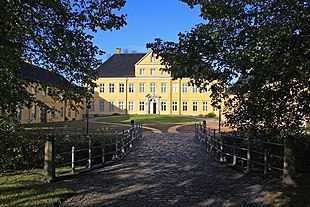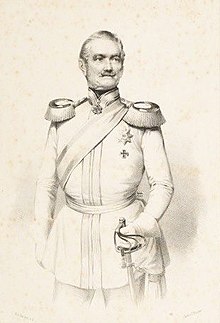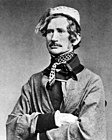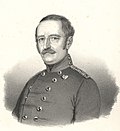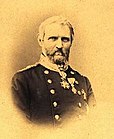Prinzenpalais (Schleswig)
The Prinzenpalais is a historic building in Schleswig .
history

The building was erected around 1700 for the privy councilor von Buchwaldt . Before that, the princely office building stood at this point. Frau von Buchwaldt sold the property to the Gottorfischen court marshal Georg Heinrich von Görtz , who gave the house its structure, which is still there today, by adding the two side wings to the central building. It is a three-wing baroque mansion with a classicist facade from a later time, which is now called the Prinzenpalais in Schleswig after one of the previous owners, Prince Friedrich Emil August from the Augustenburg line of the House of Schleswig-Holstein-Sonderburg . In March 1848, he became Minister of War in the provisional Schleswig-Holstein government and until April 7, 1850 he commanded the Schleswig-Holstein Army in the Schleswig-Holstein War . After the lost Schleswig-Holstein uprising against the Kingdom of Denmark, he had to go into exile in 1851 .
Headquarters of the General of the Danish Army
Beginning of the fighting in the German-Danish war


The palace was confiscated by the Danish occupation army and from then on served as the headquarters of the Commander-in-Chief in Schleswig during the German-Danish War . Here in the early morning of January 31, 1864, the Danish Lieutenant General Christian Julius de Meza received a letter from Field Marshal Friedrich von Wrangel from the parliamentarians Major von Stiehle and Premier-Lieutenant von Gottberg . The two officers were on Wrangel's General Staff. Major von Stiehle was á la suite of the General Staff of the Army and Adujdant in the Gouvernement of Berlin and Premier-Lieutenant von Gottberg was of the Litthauisches Uhlan Regiment No. 12 .
“The undersigned Royal Prussian General-Field Marshal and Commander-in-Chief of the United Prussian-Austrian Army, Baron von Wrangel, honors himself to make the following most devoted communication to the Supreme Commander of the Royal Danish Troops in the Duchy of Schleswig, Lieutenant General de Meza, Excellency.
By a on January 16th d. J. The note handed over by the ambassadors of Prussia and Austria, a copy of which the undersigned has the honor to enclose, the above two governments have asked the Royal Danish Government to adopt the common constitution for the Kingdom of Denmark and the Duchy of Schleswig of November 18, BC. J. repeal and thereby restore the previous status quo.
Since this request has been answered negatively by a note from the Royal Danish Minister of Foreign Affairs, dated the 18th of the same month, and since the constitution has not been repealed, the case provided for in the note has now occurred that the two German powers see themselves compelled to use the means available to them to establish the status quo and to secure the contractual rights of the Duchy of Schleswig. In this sense, the undersigned has received the order to occupy the Duchy of Schleswig with the Prussian and Austrian troops united under his command and to take over the temporary administration of the same.
By honoring the undersigned to inform Lieutenant General de Meza Excellenz of this with the utmost devotion, he attaches the request to inform him immediately whether he has the order to evacuate the Duchy of Schleswig and the Royal Danish troops from the borders withdraw the same.
At the same time he seized the occasion to express his greatest respect to Lieutenant General de Meza.
Field Marshal General and Commander-in-Chief of the Allied Army
Wrangel "
At the same time and simultaneously (on the morning of January 31, 1864) Austria and Prussia declared the planned occupation of Schleswig to the other signatory powers of the London Protocol, the United Kingdom , France , Russia and Sweden , which then took place on February 1, 1864 without any further declaration of war . According to the Danish High Command's watch book, it was 7:30 a.m. when the two parliamentarians arrived at the Prinzenpalais. The Danish guard saluted properly. According to the protocol, the two parliamentarians actually had to be presented to a high-ranking officer. But the chief of staff, Colonel Kauffmann, and other officers were on their way to inspect the defenses along the Schlei. The two parliamentarians were introduced directly to Colonel General de Meza. The eccentric Lieutenant General wore his red Turkish fez this morning and a heavy dressing gown over his uniform jacket because of the cold. In the letter, Wrangel let his opponent know that he had been commissioned to occupy the Duchy of Schleswig and at the same time asked whether he had been instructed to withdraw from the Duchy. The scene is depicted in the 1864 television film . With Theodor Fontane it's just one parliamentarian: Gustav von Stiehle :
“Major von Stiehle, charged with delivering this letter, passed the Eider on the morning of January 31, 1864, author's note. Unhindered by Danish guards, he put the path that led him through the middle of the formidable entrenchments of the Dannewerk back in an open car and stopped in front of the former palace after he had been greeted with loud cheers by the residents of the Schleswig suburb of Friederichsberg of the Prince of Noer (close to Gottorp Castle), where General de Meza had set up his headquarters. General de Meza received the Field Marshal's letter from the Major's hands, read it, winced, and tried to hide behind the unfolded letter the surprise that he could not quite master. Quickly recovering himself, he replied with the firmness that befits the tried and tested soldier: 'If the Field Marshal wants to use force - well, here we are and we are ready to receive him with arms.' "
The German officers wanted a written answer to rule out any misunderstanding, which the Danish lieutenant general promised within six hours. The two negotiators waited for the answer in a nearby hotel. There Premier-Lieutenant von Gottberg also sketched the bizarre De Meza. Then they were ordered back: the reply had been written in Latin cursive by a sub-lieutenant of the cartographic service Louis la Maire . Since Marshal Wrangel could only read the German Kurrentschrift , it was suggested that the one-sentence letter should be designed in this way. So the letter was drawn up again. At 3:30 p.m. the answer was given in the desired script and two Prussians left the Prinzenpalais again; this time without the guards greeting. Even the harsh reply was formulated in just a sparse telegram style without the usual politeness phrases and should probably act like a self-confident threat to Wrangel.
"The undersigned, who just as little the right of the Prussian and Austrian troops to occupy any part of the Danish Empire as the consistency of the letter Ew. Your Excellency is able to recognize the documents attached to it from January 30th according to its content, also from his government one of the imposition of Ew. Excellency has completely opposite instrux, is ready to counter any act of violence with weapons. "
Field Marshal Wrangel received de Meza's letter in the afternoon of the same day. On January 31, he moved his headquarters from Bordesholm Abbey to Emkendorf and was waiting for the parliamentarians in Rendsburg . The orders had already been drawn up and distributed to Bordesholm on February 29; now he didn't want to waste any more time. The wintry weather and the strong frost favored his plans: It made it possible to bypass the frozen rivers and waters of the Eider , Treene and Schlei . At 5.30 p.m. the telegraph received Wrangel's agreed command to all units to cross the Eider and attack. It read: "In God's name on it!"
The last visit of the Danish monarch to Schleswig
De Meza also reported on January 31, 1864 Warangel's letter to the king in Copenhagen. There was now absolutely no doubt that the battle for the Duchy of Schleswig, as well as the city, was imminent. Christian IX , himself born in Schleswig, believed that a visit to the front would raise the morale of his troops. He had just visited the city three weeks ago and visited his father's grave in the Schleswig Cathedral together with his son. But now, having risen to become Danish monarch, the people of Schleswig saw him more as an oppressor. Nobody had greeted him in the streets. Nevertheless, he wanted to repeat the visit. Prime Minister Monrad consented to the monarch's heartfelt wish when he promised not to use this opportunity to interfere in military matters. The king and his prime minister arrived in the city on February 3, 1864. He was greeted with the thunder of cannons from the entrenchments in Ober-Self and Lottorf and found the troops and the commanders in full confidence about the military situation. De Meza himself assured the king several times that he considered the strengthened Danewerk to be insurmountable. When the Prussian bombardment of the fortifications at Fahrendorf began on February 4th and several projectiles fell near Gottorf Castle , where the king stayed, Monrad advised the monarch to leave. Even Colonel Kauffmann agreed to take this step. So the monarch left the city on February 5, 1864, hardly knowing that he would never enter it again. Before leaving, De Meza and Kauffmann reassured the king that the wall was insurmountable and should be defended down to the last drop of blood. The monarch traveled via Flensburg to Sønderborg, where he wanted to spend the night in Sønderborg Castle . Having just arrived there, he heard over the telegraph that De Meza and his staff had decided to vacate the Danewerk.
De Meza's last council of war
On the afternoon of February 5, at 5 o'clock, Lieutenant General de Meza held his last council of war here with all the generals and senior officers who were present. At this hour it was clear to the Danish officers that at least 23,000 Prussians would cross the Schlei at Arnis , 26,000 Prussians and Austrians would be standing in front of the Danewerk and 11,000 Prussians at Missunde . These 10 officers were:
Also:
• Major Schröder
• Major Wegner
It was decided to move away from the Danewerk. The decision was taken almost unanimously at 6 p.m., only Lieutenant General Lüttichau raised objections. As an artillery officer, he did not want to give up the guns. The motivation of this decision was explained in seven points:
Considering
- that the durability of the Danes is based on the obstacle afforded by the Eider, the Schlei and the floods. However, that the Schlei's obstacle is currently only a gully and that it is impossible to move in the immediate vicinity of the enemy.
- that camping and bivouacking is impossible in the important sections of the year.
- that to defend the position an army strength of 40 - 50,000 men are necessary, the current strength is 35,000 men.
- that the composition and training of the army are inadequate.
- that the enemy has gathered at least 50,000 men and has thus occupied the terrain which should be occupied by our outposts for security and which can hardly be regained. The enemy has also already established its artillery.
- that an orderly retreat after the breakthrough is impossible.
- that the instruction of the War Ministry of January 22, 1864 to the Chief General, as a condition for the resistance, required not to continue the fight so far that the existence of the Army as an army would be compromised.
From all of this, it was concluded that a voluntary withdrawal, leaving all the material in the positions behind, should take place in the early hours of February 6th. On February 6, 1864, the Danish army finally withdrew with its lieutenant general. He gave the order for evacuation without a fight and left enormous values behind: 135 guns, 113 quintals of powder, 136,000 rounds of ammunition, tons of tools, blankets, straw, hay, wood and bacon.
Further use
The building was then used as the archives of the Lübeck part of the state in 1867 and as the administrative building of the Schleswig-Holstein province from 1937 . It remained in the state ownership after 1946, but was used for various purposes. It was gutted in 1979 and, after 13 years of planning and construction, handed over to its current purpose as the Schleswig-Holstein State Archives on September 17, 1991 . The archive of the Christian-Albrechts-Universität zu Kiel has been kept as a deposit in the state or state archive since 1934. In 1991 he moved from Gottorf Castle to the Prinzenpalais. The research center for regional contemporary history and public history has also been housed in a wing of the palace since 1992 .
literature
- Oliver Bruhns: Schleswig city stories , in: Reimer Witt, Oliver Bruhns: 1200 years of Schleswig. ed. from the Lions Club Schleswig, 2006.
- Tom Buk-Swienty : Slaughterhouse Düppel: April 18, 1864. The story of a battle . Osburn Verlag 2011, ISBN 3-940731-72-2 .
- August Trinius : History of the war against Denmark 1864 . Rockstuhl 2011, ISBN 386777398X , p. 53.
Web links
Individual evidence
- ↑ August Trinius: History of the War against Denmark 1864, Rockstuhl 2011, ISBN 386777398X , p. 53
- ↑ Gerd Stolz: The German-Danish fateful year 1864. Husum 2010, ISBN 978-3-89876-499-5 , p. 46.
- ↑ January 30, 2014 DIE ZEIT No. 6/2014
- ^ Theodor Fontane: The Schleswig-Holstein War in 1864, Berlin 1866, p. 77
- ↑ a b August Trinius: History of the War against Denmark 1864, Rockstuhl 2011, ISBN 386777398X , p. 54
Coordinates: 54 ° 30 ′ 19.6 ″ N , 9 ° 32 ′ 21.9 ″ E
